Are you a yellow lover? Thus the yellow brick road is waiting to join your homes and gardens. There is no doubt that greenery cools the eyes and heart. Choose cacti with yellow flowers if you want some refreshing addition around you. Many people desire evergreen ornamental house plants but are not aware of colorful cacti. Let’s take a look at yellow cactus types from around the world.
Yellow cacti are plants that need little attention for thriving indoors and outdoors. Some yellow cacti prefer cool climates for flowering and can illuminate any place. They look fantastic in pots, containers, hanging baskets, sunny borders, rockeries, and playlands.
Yellow Cactus Types
We carefully collected 12 world-famous yellow cactus varieties for homes and gardens to meet everyone’s personal preferences
1. Astrophytum capricorne (Goat’s Horn Cactus)
A trendy cactus, “Astrophytum capricorne,” grows in the Chihuahuan desert of Mexico. This weird cactus is green by nature but looks gray from a distance because of white patches on the plant body. These cacti may be ovate to rounded and about 1.3 m high and 16 cm wide. They consist of 7 to 8 sharp, twisted ribs and 10 to 11 yellowish-gray 8 cm long spines.
It is a low-growing drought-tolerant desert plant. It gives large dazzling flowers in favorable conditions after 2 to 3 years. Flowers are 6 to 7 cm wide, scented, and yellow with reddish-orange centers. Goat’s horn cactus can grow in large containers or pots. Although, growing these cacti in the outdoor succulent gardens will be better.
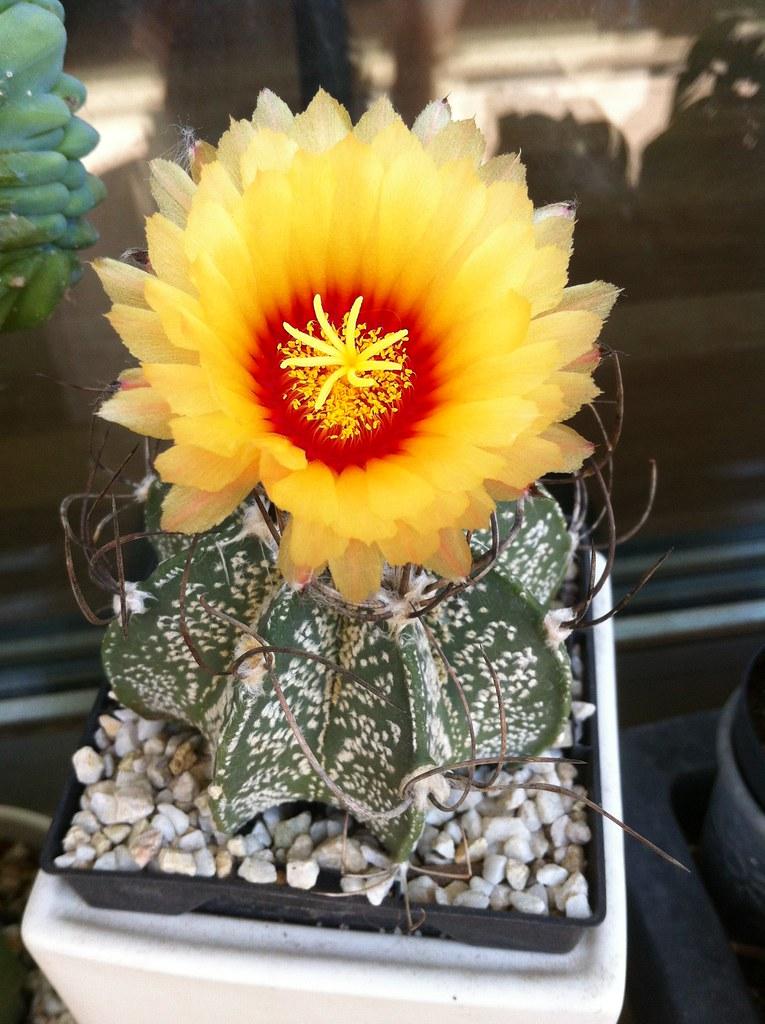
Astrophytum capricorne
2. Cintia knizei (Rebutia cintia)
Cintia knizei is a solitary, spherical to tubular, and dwarfish cactus that rarely endures the Andean areas of Bolivia. Lime green to purplish-brown cylindrical stems with podaria can grow about 5.5 cm high in diameter. This yellow alpine cactus possesses 11 cm long turnip-like swollen roots. Only young areolas bear 4 to 6 small spines, but the hypanthium of adult plants lack spines.
Cintia knizei produces 4.5 cm large yellow diurnal flowers on the top of the apex in early summer. However, it requires full sun and dry climates; hence growing this cactus outside will benefit its growth.
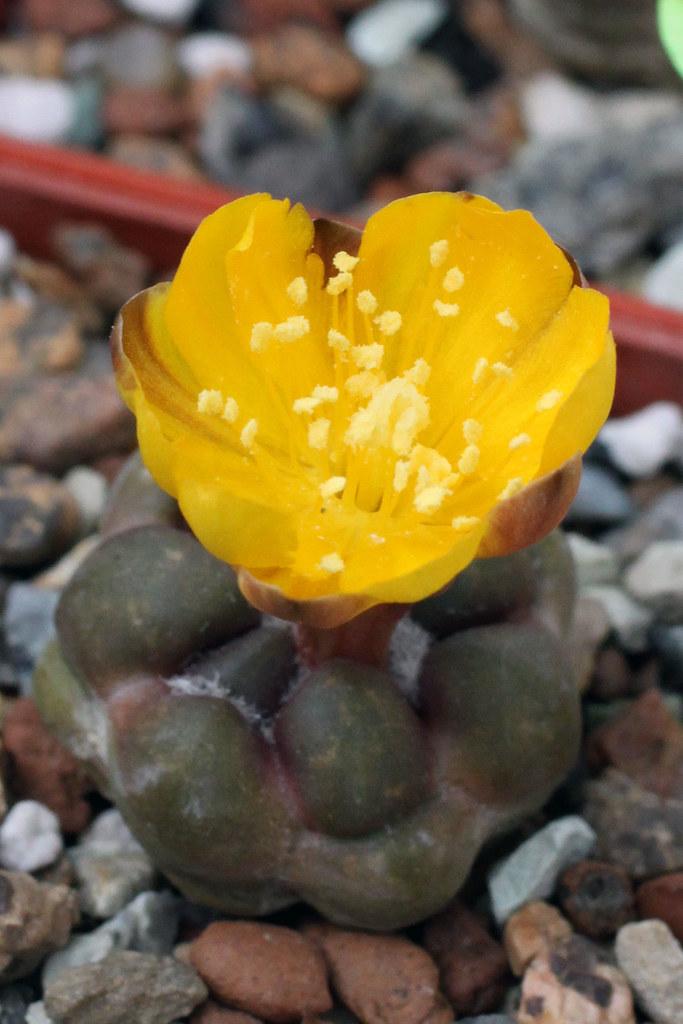
Cintia knizei
3. Copiapoa humilis
Copiapoa humilis is a cute short, most common and low-growing cactus of chile. It spreads in clusters of yellowish-green or brown stems. These stems are semi-globular and depressed that reach 6.5 cm high and 9.5 cm wide. Various White wool appears between the silver, black spines on stems. It has turnip-like large roots filled with storage water. Flowers are bright yellow 4.5 cm long that appear in spring or summer.
It is a summer species of copiapoa that requires direct sunlight to partial shade for its growth. It will be wise to plant this cactus in an outdoor cactus garden. When winter comes, it is better to move this plant inside and protect it from frost.
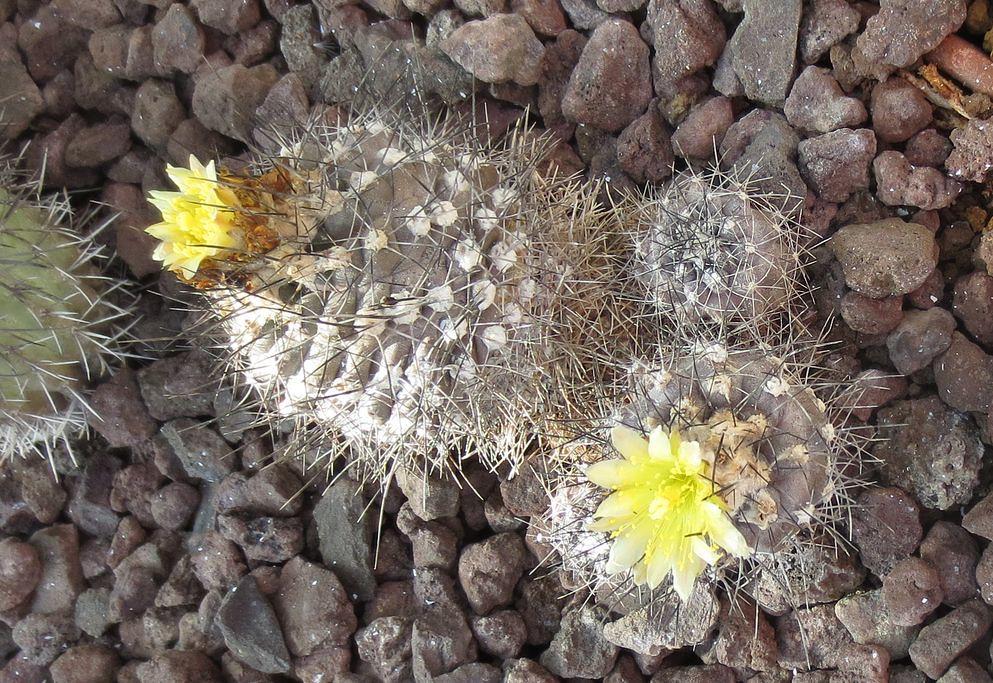
Copiapoa humilis
4. Cumulopuntia sphaerica (Tephrocactus sphaericus)
Cumulopuntia sphaerica grows near the seaside of Chile and Peru. It is a tiny plant with a height of 15 cm and forms 2 to 5 cm long egg-shaped segments. This cute cactus cannot grow very tall because of the 2 to 4 parts’ withering and developing new colonies. It has 2 to 4 cm long 15 spines that may be smooth to curved and red or brown.
Cumulopuntia sphaerica features unique yellowish-orange 4.4 cm long flowers. These flowers look very big compared to the rest of the plant body. Six hours per day summer full sun is necessary for this healthy cactus. It is best for mountainous areas and deep pots due to its large swollen taproots.
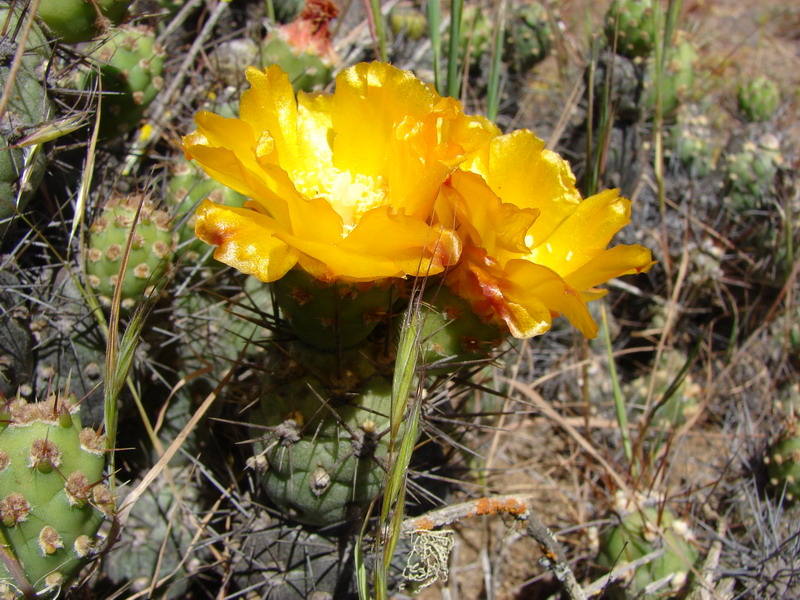
Cumulopuntia sphaerica
5. Echinocactus grusonii (Golden Barrel Cactus)
Echinocactus grusonii is one of the world-renowned plants of the Royal Horticulture community. It is a globular to elliptical cactus of the Southwestern United States and Mexico. This barrellike cactus features light golden spines on the yellowish-green apex. It has ribbed stems that are 60 cm high and 60 to 80 cm wide.
It shows 4 to 5 cm wide showy yellow flowers in late spring or early summer. Golden barrel cactus can survive the drought for a long time. Thus, it is perfect for succulent outdoor gardens. It also looks drop-dead gorgeous if grown in containers or larger pots.
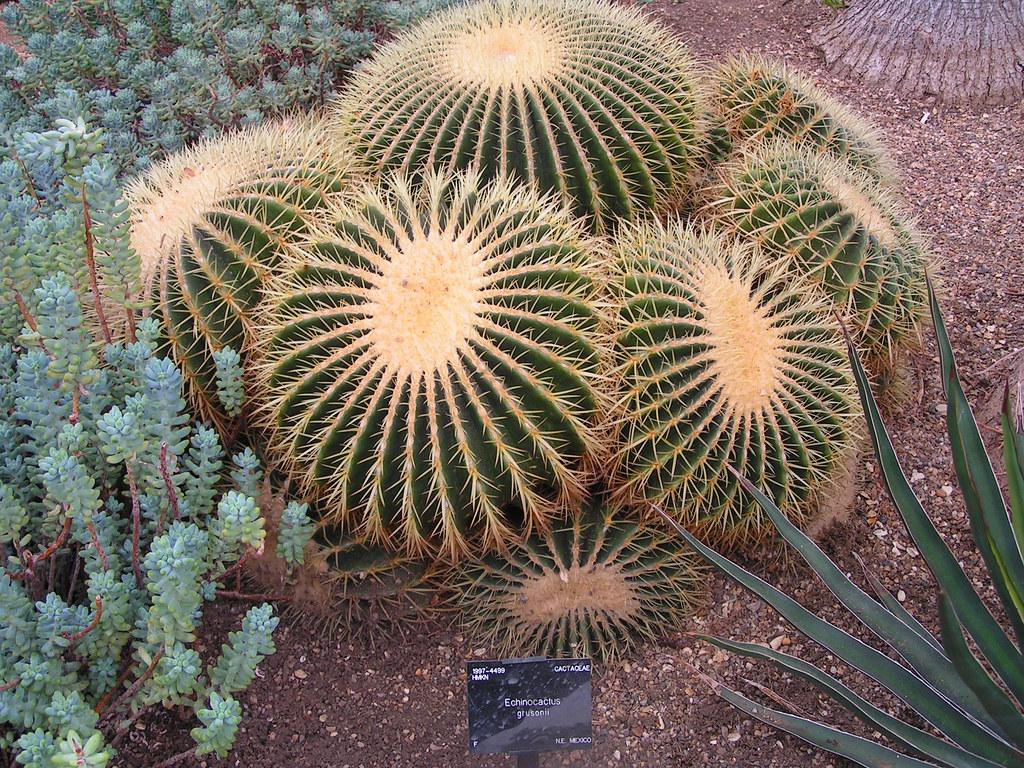
Echinocactus grusonii
6. Echinopsis ancistrophora (Dominos Easter Lily)
Echinopsis ancistrophora slowly thrives in the grasslands and forests of Southern America. Unfortunately, this yellow cactus is near extinction due to overgrazing, agriculture, and urbanization. This small cactus forms clumps of 4 to 8 cm long stems that are semi-globular, depressed, and deep green.
Dominos has short curved spines, but some species lack spines. It flourishes with showy yellow large flowers in summer. It is a lovely container houseplant that shows prevalent growth in rock gardens.

Echinopsis ancistrophora
7. Echinopsis aurea (Golden Easter Lily Cactus)
This short rounded to tubular Echinopsis species originates from North Argentina. Solitary deep green stems grow up to 15 cm high and 10 cm broad with 12 to 15 grooved ribs. Two types of spines, the radial and central spines surround the whole plant. 3 cm long, four dark central spines are straight and harder than ten radial spines 1 cm long.
Echinopsis aurea gives 9 to 10 cm long conical-shaped hairy pale yellow flowers. These bright flowers emerge from the sides of this cactus in early summer. Echinopsisi aurea is best suited for pots, containers, terraces and succulent outdoor gardens.
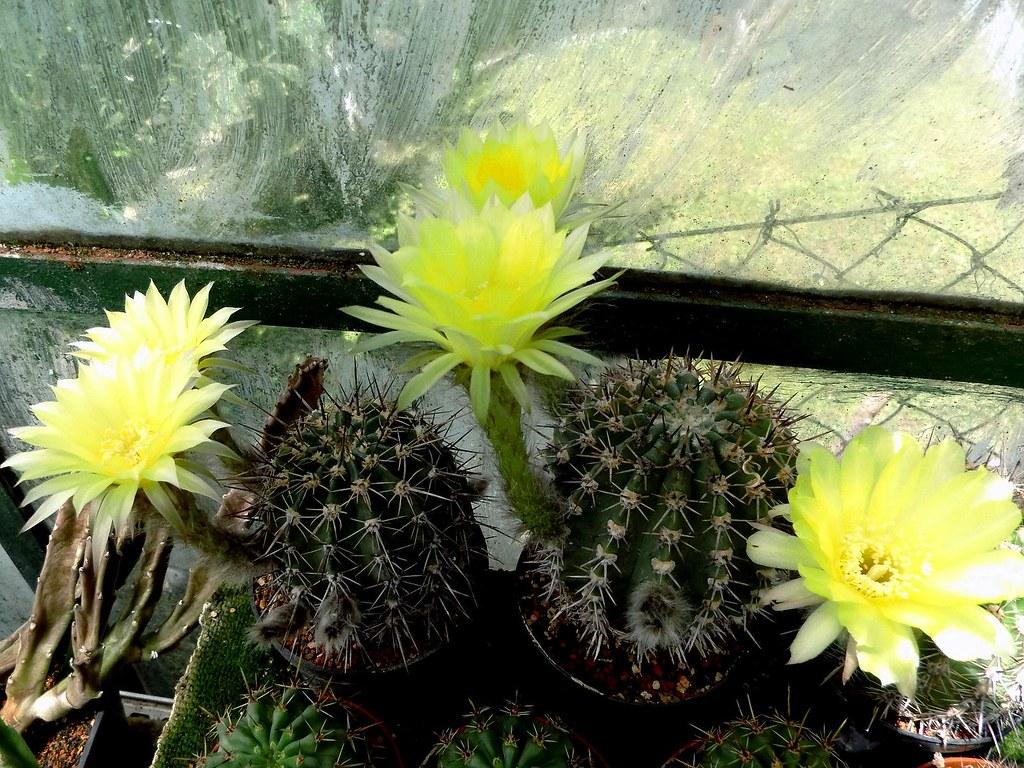
Echinopsis aurea
8. Ferocactus cylindraceus (California Barrel Cactus)
This yellow cactus is famous for many common names such as Compass Barrel, Desert barrel cactus, miner’s compass, and California Barrel cactus. This striking yellow cactus grows in the Mojave and Sonoran deserts of California, Arizona, and Mexico.
It forms 5 to 6 feet rounded to tubular upright stems. Each areole produces 15 to 32 golden, red or brown spines in young plants, but mature plants show grey and curved spines. It has sun-facing flowers at the middle top of the plant crimson with bright yellow centers.
Ferocactus cylindraceus is best to grow outdoors; thus, it is most suitable for rock, gravel, and desert gardens.
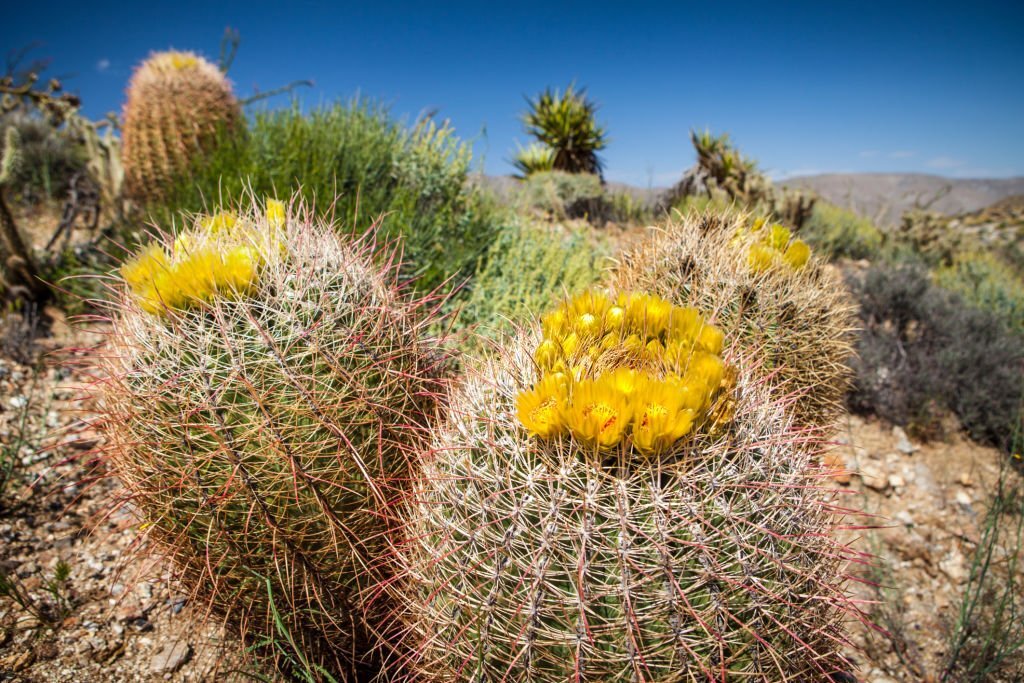
RELATED: Growing Tips and Facts About Jumping Cholla Cactus, Desert’s Most Mesmerizing Plant
9. Frailea castanea (Frailea asterioides)
Frailea castanea is a tiny dark brown to greenish maroon cactus of Uruguay and South Brazil. These unique-looking cacti comprise 8 to 15 ribbed globe-shaped stem that is 5.5 cm long in diameter. The plant body bears 4 to 15 short, curved, and black spidery spines.
It produces 4.5 long peculiar pale yellow flowers which are somewhat larger than the total size of the plant body. Frailea castanea loves warm weather and happily grows in outdoor succulent and desert gardens. This cactus is not frost-tolerant; thus, grow it in pots or containers and place them in warmer rooms.
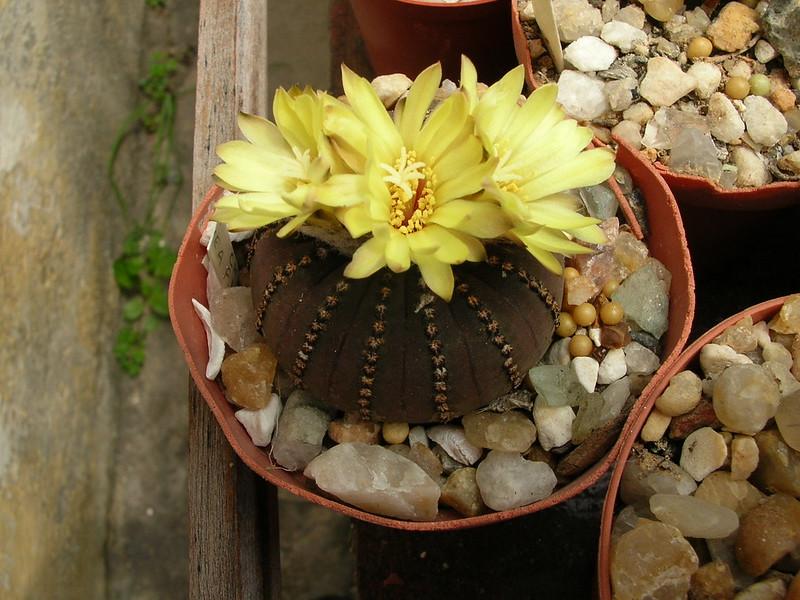
Frailea castanea
10. Leuchtenbergia principis (Agave Cactus)
Leuchtenbergia principis is a single, distinctive species that comes from Northern-Central Mexico. This yellow cactus slows down in growth but randomly spreads over large areas. It has a robust taproot and aerial disc-shaped stem that grows 50 to 60 cm in length. It bears 2 to 3 inches long and thin blue-green tubercles with paper-thin spines at their edges.
It is popularly known as agave cactus because of these harmless papery spines. Cone-shaped large and light yellow flowers appear at the tips of tubercles after 3 to 4 years. This Leuchtenbergia species is not frost-resistant but can withstand heavy rain hence a great yellow addition to rockeries. It is a sparking choice for terraces and greenhouses.
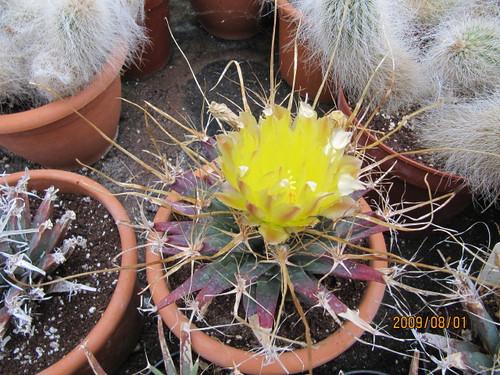
Leuchtenbergia principis
11. Matucana aureiflora
Matucana aureiflora originates from tropical montane forests and Peru. The stem is prostrate globe-shaped dark green, about 10 cm long and 12 cm broad in diameter. This apex consists of scaled leaves and transparent brownish-yellow curved spines.
This cactus blooms in summer and shows large, golden yellow, and cathemeral flowers. These elegant-looking flowers can be 5.5 cm long and 2 to 4 cm wide in diameter. Matucana aureiflora can survive slight frost, but it’s better to grow it in deep pots indoors in winter rather than outdoors. Only plant this cactus outdoors in direct sunlight in summer but protect it from intense heat.

Matucana aureiflora
12. Mammillaria longimamma (Finger Cactus)
Sea Urchin looking unique Mammilaria longimamma is the large-sized famous ornamental cactus that belongs to Texas and Mexico. Globular-shaped young finger cactus forms 10 to 15 cm wide clusters with 30 to 50 branches. Stems lacking latex are spherical, pale green, about 10 to 20 cm high and 10 to 12 cm wide.
It features distinctive long finger-shaped roots with 4 to 8 long tubercles. It bears 26 mm long dark yellow 2 to 3 central spines and 10 to 20 mm long bright yellow 6 to 12 radial spines. This cactus blooms from May to July and gives large yellow about 5 to 6 cm wide and conical-shaped flowers.
Mammillaria longimamma is easy to grow with succulents like Agaves, Ferocacti, and Opuntias. This cactus is little cold hardy cactus thrives happily in rockeries, Mediterranean gardens, and coastal areas. Thus, it cannot survive the frost and is best to grow in the deep pots inside in the winter.
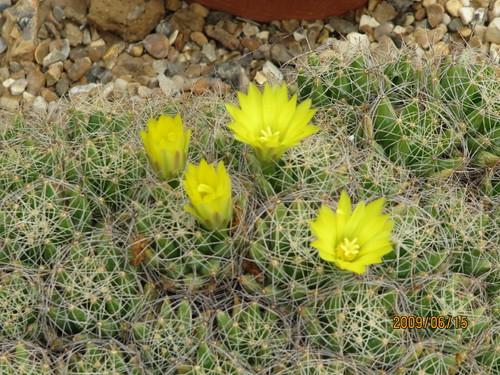
Mammillaria longimamma
13. Opuntia engelmannii (Cactus Apple)
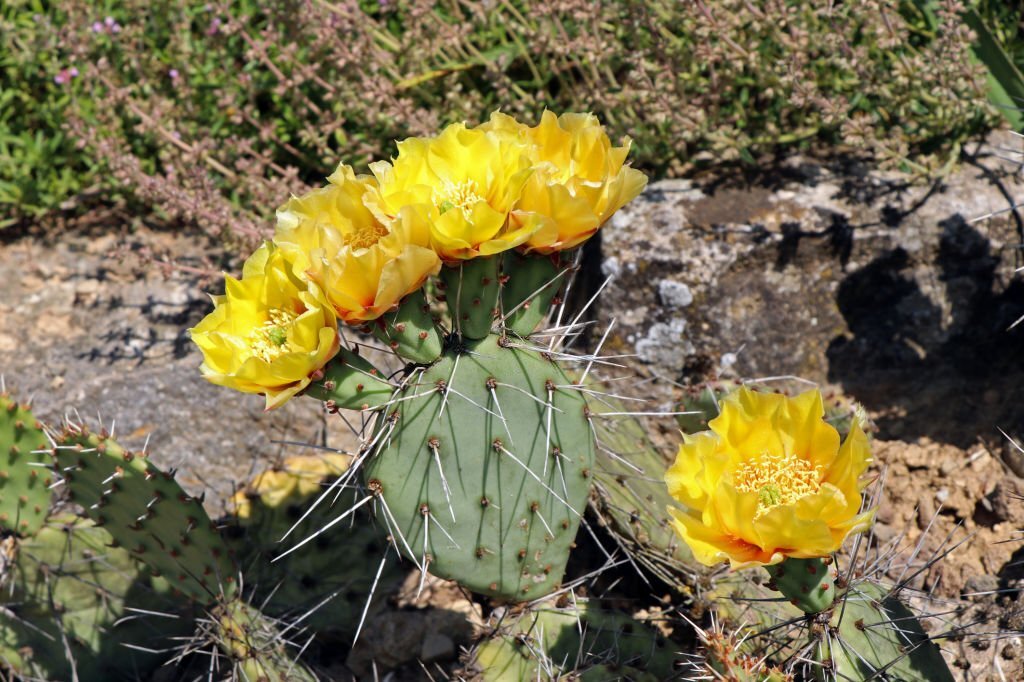
14. Opuntia microdasys (Bunny Ears Cactus)
This cactus has many common names like Bunny Ears Cactus, Polka dot Cactus, Golden Bristle Cactus, and Angel’s Wings. This slow-growing cactus belongs to the arid deserts of Arizona and Mexico. Opuntia microdays have stem-like green slippery pads with white to yellow spine markings called glochids. Stems are spherical to ovate and reach 1 to 3 feet high with 3 to 6 feet width.
Conical-shaped golden yellow flowers with red outlines are 5.5 cm long and 5 cm wide. It’s lavender and burgundy egg-shaped fruits are edible. Bunny cactus is most suitable for larger containers, edible gardens, and drought-resistant gardens.
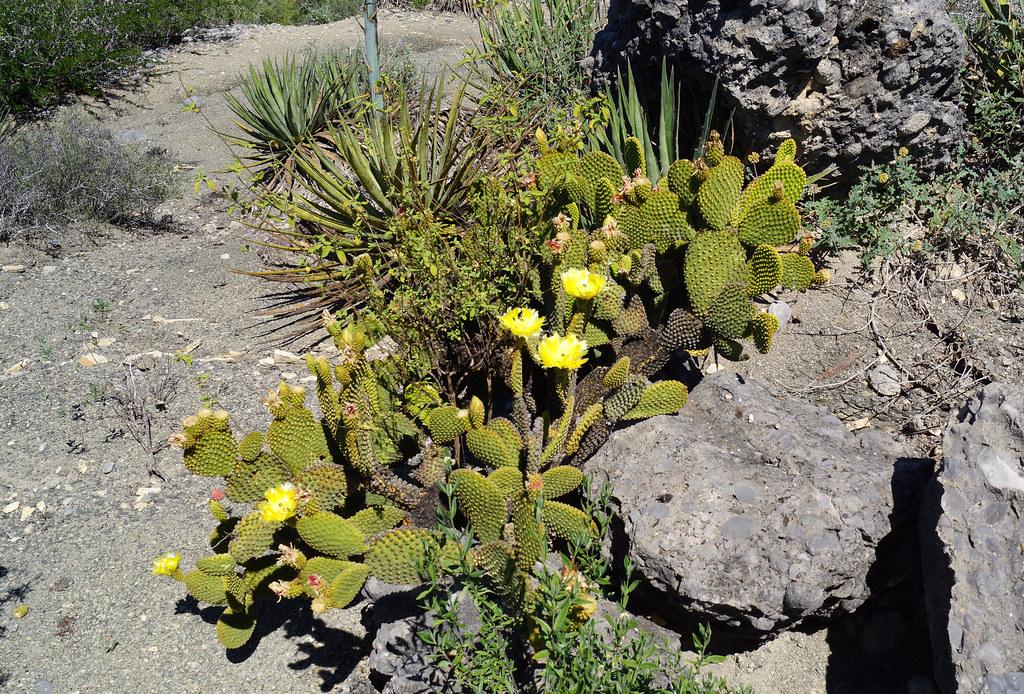
Opuntia microdasys
15. Oroya borchersii (Echinocactus borchersii)
Oroya borchersii is a beauteous crowned yellow cactus that spreads randomly near the Santa river of northern Peru. It forms single or clumps of rounded to tubular stems about 10 to 32 cm high and 12 to 22 cm broad. These branched stems have 10 to 30 ribs with 1.5 to 2.5 cm long yellow-tan central and radial spines surrounding the whole plant.
Central spines are 1 to 3, while 20 to 30 radial spines resembling the comb-teeth are paper-thin. It rarely produces 2 cm long and 1.6 cm wide yellowish-green trumpet-like flowers in summer. Nevertheless, it is a striking outdoor fast-spreading cactus that can withstand the cold even less than -15 C.

Oroya borchersii
RELATED: Ten Extraordinary Types of Tall Cactus Can Revive Your Yards and Landscapes
16. Parodia magnifica (Yellow Ball Cactus)
This spherical yellow cactus is, also known as Notocactus magnificus grows in the grasslands of Brazil, Argentina, and Paraguay. It has a somewhat tubular green stem that consists of 10 to 15 ribs with clumps of bright golden spines.
Parodia magnifica stems reach 20 to 22 cm high and 16 cm diameter. As this cactus ages, it turns blue-green and propagates in clusters. IUCN red list declared Parodia magnifica as a threatened plant species and warned about its extinction soon.
Yellow ball cactus gives clusters of 2.3 inches long, small, showy, and yellow flowers at the tips of plants in early summer. It is a tremendous outdoor Parodia species that can withstand lower temperatures but protect it from dampness. Baby cacti thrive happily as single potted specimens until it forms clusters.

Parodia magnifica
17. Rebutia breviflora
Rebutia breviflora propagates in clusters in the rocky crevices of Bolivia, Cochabamba, and Potosi. Stems are spherical to tubular, riblike or tuberculous with taproots. These cacti are quirky due to their large yellow flowers that look stunning cone-shaped. Rebutia breviflora is a fast-growing hilly plant that loves cool temperatures.
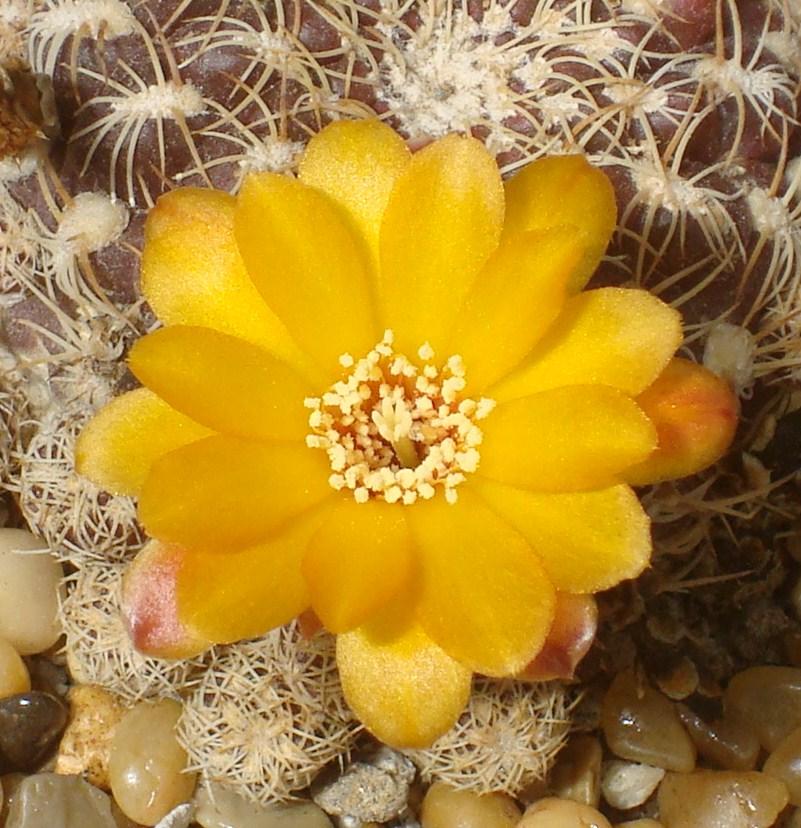
Rebutia breviflora
18. Schlumbergera truncata (Christmas Cactus)
Schlumbergera truncata popular names are Crab cactus, Holiday cactus, and Thanksgiving cactus. This winter-loving cactus grows on the mountains of the tropical and subtropical forests of south-East Brazil. Paper yellow Christmas cactus lack true leaves and consists of stem-like cladodes.
Cladodes are flat to rounded, green, hairy, and shiny, consisting of crablike claws or cladophylls at their ends. Cladodes can be 6.5 cm long and 4 cm wide in diameter. Christmas cactus blooms in winter and gives 1 to 3 inches long tube-shaped yellow flowers. It is the world-famous epiphytic cactus for rock and gravel gardens. It is also an excellent decorative arching plant for pots and hanging baskets.
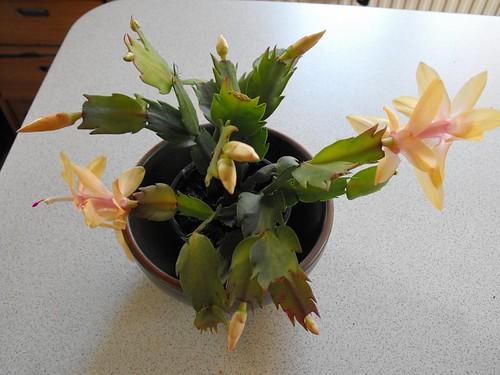
Schlumbergera truncata
Frequently Asked Questions
Is it true that yellow cacti are rare?
Cacti with bright yellow flowers are not easy to find in nurseries because they are rare. Unfortunately, yellow cacti are not perennial and produce flowers only in December and February. Large Yellow and showy flowers can be long-lasting in favorable conditions like cool climates, well-drained soils, and fertilizer contents. However, all heat sources and excessive watering can prevent these cacti from flowering.
How to save a yellow cactus?
Like all cacti, yellow cactus also needs proper care and little maintenance; thus, you can save these plants from dying by following these guidelines.
- Do not overwater the yellow cactus because it can cause rotting. Instead, if the cactus plant looks infected with brown or black rots, try to cut these rotted sections of the cactus immediately.
- Yellow cactus requires cool temperatures to show good results. Excessive sunlight can burn them; they can lose their beautiful yellow colors.
- Clean the litter and other dirt around the cactus plant because these wastes can stop the photosynthesis process.
- Some insects like spiders, mites and mealybugs are harmful to yellow cacti and kill them. Many solutions to control these pests and insects are available in nurseries. One of the most effective ways to kill spider mites and mealybugs is alcohol spray over plants.
- Always use low nitrogen fertilizers because excessive fertilizers can affect plant growth.
Is it normal if a cactus turns yellow?
Yellow cacti are stunning varieties of cacti that are trendy but rare plants. Young cacti are green and turn yellow or red when they are mature. On the other hand, cacti with yellow flowers are naturally yellow cactus, and there is no need to worry about it.
After learning about Yellow Cactus types, make sure to check out our other cacti and succulents articles:
Se-Dum Beautiful! The Ultimate Guide To Sedum Flowers
Let There Be Light! How Much Light Your Succulents Need To Grow







